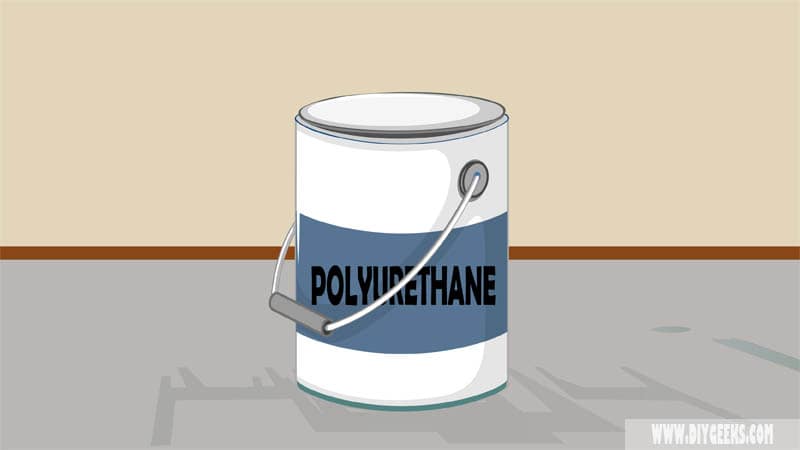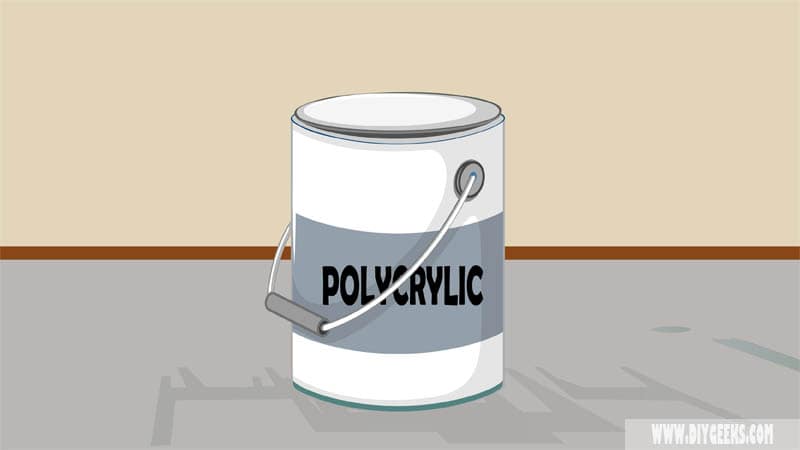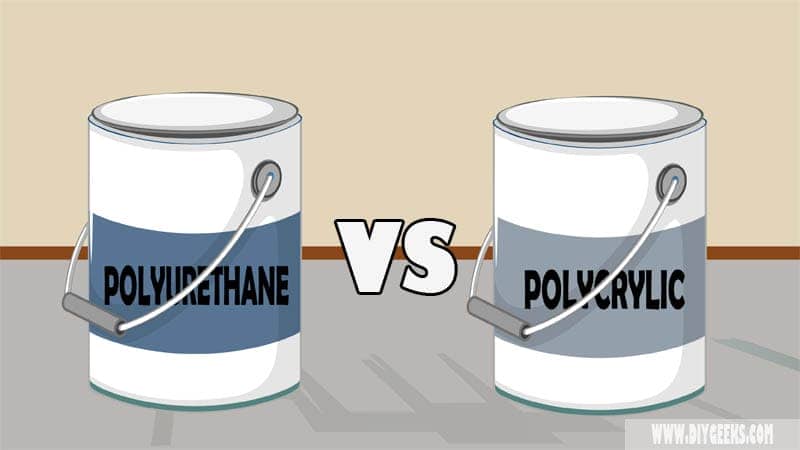Polyurethane is a sealer used to protect indoor and outdoor surfaces from constant water, moisture, or scratches. Polycrylic is a water-based sealer that protects low-traffic indoor surfaces from moisture.
Polyurethane offers better protection and moisture resistance, while polycrylic dries faster, can be used indoors, and doesn’t yellow over time.
What is Polyurethane?

Polyurethane is a protective coating formulated with polyurethane resins that creates a plastic-like layer (barrier) over the surfaces and protects them from moisture, water, scratches, and weather elements.
There are two polyurethane types; water-based and oil-based polyurethane. Water-based polyurethane is used for indoor surfaces that don’t need much protection, while oil-based polyurethane is used for exterior surfaces.
The Polyurethane advantages are listed below.
- Water-resistance finish.
- You can apply it over outdoor high-traffic surfaces.
- Easy to apply.
- Durable finish.
The Polyurethane disadvantages are listed below.
- Long dry time, especially the oil-based type.
- Oil-based poly tends to yellow after a while.
What is Polycrylic?

Polycrylic is a water-based sealer used to protect indoor low-traffic surfaces from moisture, water, or scratches. Since polycrylic is water-based, the sealer dries fast, can be used indoors, and doesn’t yellow.
It’s produced by the Minwax company and its term is commonly used to refer to water-based polyurethane from different manufacturers.
The Polycrylic advantages are listed below.
- Water-based formula.
- It doesn’t yellow over time.
- You can use it for indoor surfaces.
- Easy to clean and maintain.
- Transparent finish.
- Fast dry time.
The Polycrylic disadvantages are listed below.
- It’s more likely to drip while applying it.
- Low moisture-resistance levels.
- Not durable enough for exterior surfaces.
Polyurethane vs Polycrylic
The differences between polyurethane and polycrylic are listed below.
- Polyurethane has a transparent finish that can yellow over time, while polycrylic retains its clear finish for years.
- Polyurethane protects the surfaces better.
- Polyurethane creates a better moisture-resistant layer (barrier) than polycrylic.
- Polycrylic dries faster.
- Polycrylic is easier to apply over small surfaces, while polyurethane is easier to apply over large surfaces.
Appearance
Polyurethane has a clear (transparent) finish and different sheen finishes– from flat (matte) to high-gloss sheen. Oil-based polyurethane finish tends to turn yellow gradually, while water-based polyurethane can turn cloudy (or blurry).
Polycrylic retains its transparent clear finish for years without turning yellow or blurring because it doesn’t contain oily deposits on its formula.
Durability or Wood Protection
Polyurethane protects surfaces better than polycrylic.
Polyurethane creates a glossy finish that offers good wood protection, moisture resistance, and resistance to wear and tear. Exterior polyurethane offers weather resistance and protects the surface from outdoor elements, such as rain or UV rays.
Polycrylic can protect low indoor surfaces, such as cabinets or drawers, from scratches or moisture, but it can’t protect outdoor high-traffic surfaces. Polycrylic will get removed or washed off if exposed to constant water or moisture.
Polycrylic isn’t durable. It can protect your cabinets, drawers, and shelves from scratch marks and dents because these are low-traffic surfaces that don’t get a lot of use.
Moisture Resistance
Polyurethane offers better moisture-resistance qualities than polycrylic.
Polyurethane creates a glossy moisture-resistant layer (barrier) over the surface and protects it from constant water or moisture.
Polycrylic forms a low water-resistant layer (barrier) that can prevent low moisture penetration, but the finish gets washed off if exposed to constant water.
Since polycrylic is water-soluble, its finish can be gradually removed if applied to high-moisture surfaces.
Dry Time
Polycrylic dries faster than polyurethane as it has a water-based formula. Both sealers dry through solvent evaporation.
Polycrylic takes around 2 hours to dry between coats, and between 24-48 hours to cure (dry fully).
Water-based polyurethane takes around 6-8 hours to dry between coats and around 24 hours to cure (dry fully). Oil-based polyurethane takes around 24 hours to dry between coats and around 48-72 hours to cure (dry fully).
Application
Polyurethane is easier to apply over large surfaces, while polycrylic is easier to apply over small surfaces.
You can apply polyurethane with a paint sprayer, brush, or roller. If you use a sprayer you must thin polyurethane before applying it.
You can apply polycrylic with a paint sprayer, brush, or roller. However, the sealer is more likely to drip while applying it, especially on large and vertical surfaces.
Since polycrylic dries fast, you must fix the coating drips faster while applying it or they can dry and become harder to fix.
Pro tip: Use polyurethane for large surfaces since it’s less likely to drip over the surface. Use polycrylic on small surfaces, so you can control its runny consistency better.


